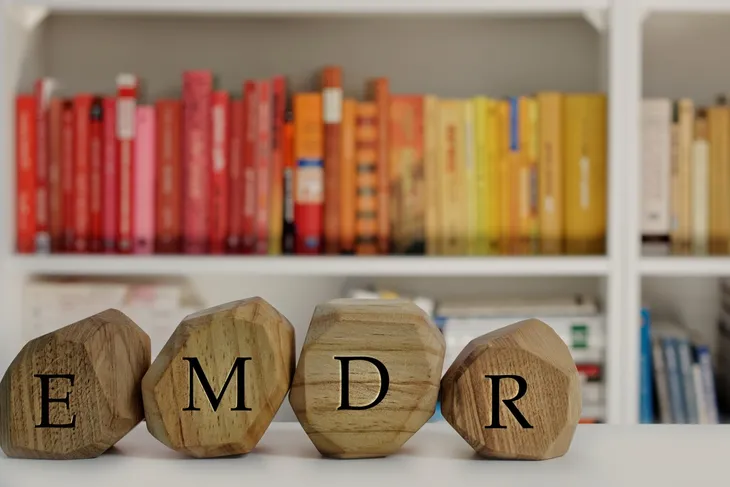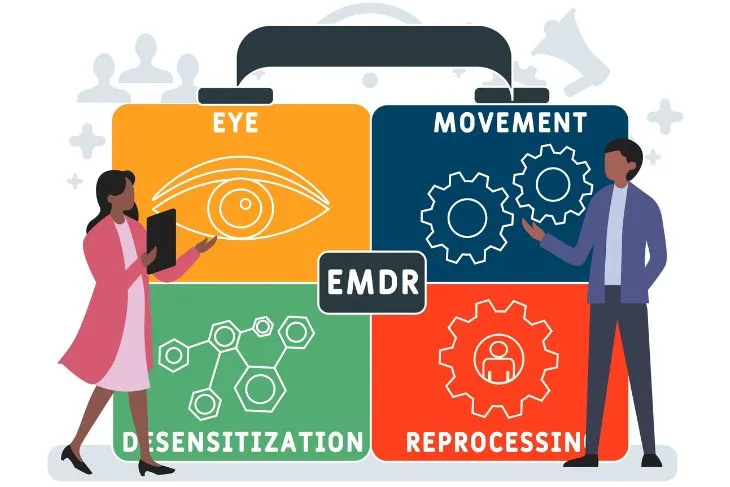- EMDR therapy uses bilateral stimulation to help patients heal from their trauma or other distressing life experiences.
- It has proven effective for treating traumatic memories and symptoms of PTSD.
- Other benefits include changing negative thinking, decreasing chronic pain, and boosting self esteem.
- Potential side effects are unpleasant, vivid and realistic dreams, retraumatization, heightened awareness, as well as an emotional and financial burden.
When we think of therapy, most of us picture someone sitting on a couch in a fancy office talking about feelings. But mental health is a very complex subject which means there isn’t a one size fits all approach.
One of the more recent approaches to therapy is a nontraditional type of psychotherapy called eye movement desensitization reprocessing (EMDR). It has become increasingly popular for treating post-traumatic stress disorder (PTSD). To learn more about it, here’s a look into what it is, how it works, if it’s effective, and the potential risks and benefits…
What is EMDR Therapy?
EMDR stands for eye movement desensitization reprocessing therapy. It is a mental health treatment technique that uses bilateral stimulation. Patients move their eyes rhythmically from left to right while processing traumatic memories, explains the Cleveland Clinic. The goal is to help them heal from their trauma or other distressing life experiences.
When considering other forms of therapy, EMDR is relatively new but has been around for over 30 years. The first clinical trial was in 1989 after it was first developed by psychologist Francine Shaprio to treat PTSD. There have since been dozens more, all of which prove this technique is effective and yields faster results than most other methods, notes the source.

Is It Effective?
Since it was first introduced in the late ’80s, there have been studies and trials to support the effectiveness of EMDR. For example, a 2014 review of 24 studies found EMDR was useful in relieving emotional distress from adverse experiences, may be more effective and work more quickly than cognitive behavioral therapy (CBT), and ease somatic symptoms, such as pain or muscle tension. This has led both the American Psychological Association and Department of Veterans Affairs to recommend EMDR as a treatment for PTSD.
Another small pilot study found EMDR to be safe and effective for treating PTSD in people with a psychotic disorder. There are also studies looking at EMDR to treat the symptoms of panic disorder, depression, psychosis, trauma symptoms, and non-traumatic symptoms.

What Conditions Does it Treat?
While EMDR is for people dealing with traumatic memories and symptoms of PTSD, Healthline notes it can also sometimes be helpful for any person who finds it hard to share their trauma through talk therapy. The research among other health conditions is limited, some mental health professional may recommend it.
The Cleveland Clinic lists the following as other common conditions that can be treated with EMDR:
- Anxiety disorders: generalized anxiety disorder, panic disorder, phobias, and social anxiety/phobia
- Depression disorders: major depressive disorder, persistent depressive disorder and illness-related depression
- Dissociative disorders: dissociative identity disorder or amnesia and depersonalization or derealization disorder
- Eating disorders: anorexia nervosa, bulimia nervosa, and binge-eating disorder
- Gender dysphoria (when a person doesn’t relate to the gender they were born with)
- Obsessive-compulsive disorder (OCD): OCD, body dysmorphic disorder, and hoarding disorder
- Personality disorders: borderline personality disorder, avoidant personality disorder, and antisocial personality disorder
- Trauma disorders: acute stress disorder, PTSD, and adjustment disorder

How Does it Work?
Phase 1: History and Treatment Planning
The first step is to meet with a therapist who has been specially trained in EMDR. Before doing any treatment, they will review any symptoms the patient is experiencing and go through their personal and medical history. This helps them get to know the patient so they can better understand where to start.
While EMDR is praised on the lack of talking required, this phase does require the patient to briefly discuss their trauma and any memories that need to be addressed.

Phase 2: Preparation
Preparation is the next phase and is where the therapist teaches the patient about different techniques they can use to help manage and cope with the emotional or psychological stress they are experiencing, explains Healthline. This includes any uncomfortable feelings that might surface during their treatment.
According to the source, this practice is called resourcing. For example, a common stress management technique that can help work through this type of stress are deep breathing and/or mindfulness exercises.

Phase 3: Assessment
The third phase is assessment. It’s during this phase that the therapist and client choose a specific memory to target during the treatment. The therapist guides their patient through the process of selecting a specific memory, “along with any relevant aspects of that memory,” writes Healthline.
Some relevant aspects that they need to identify are painful emotions associated with it. This includes any physical sensations. Other aspects might be “intrusive thoughts or images,” as well as distressing or unwanted self-beliefs, adds the source.

Phase 4-7: Treatment
As Healthline explains, phases 4 to 7 all contribute to the overall treatment. This is where they begin to use EMDR therapy techniques to address the targeted memories they previously discussed. These phases will occur in four stages: desensitization, installation, body scan, and then closure.
During the desensitization stage, the patient focuses on that negative thought, memory, or image. While doing this, they are guided through bilateral stimulation (BLS), “which might involve making specific eye movements, tapping, audio tones, or blinking lights,” writes the source. Let the mind go blank and make note of any thoughts or feelings. After identifying these, the therapist might have their client refocus on this traumatic memory or move onto another if it “no longer triggers unwanted emotions.”
The next stage is installation. The patient must “install” a positive self-belief or image to replace the negative one from phase 3. They focus on this new belief or image through another repetition of BLS, explains Healthline. Next is the body scan — where the therapist asks if the targeted memory causes any uncomfortable pains or sensations. If yes, they are guided through another round of BLS. Lastly, closure is when the therapist explores the progress and suggests relaxation techniques and other coping strategies that will lead to further improvement.

Phase 8: Re-Evaluation
The re-evaluation phase is the last and final step. During this phase which begins in its own whole new session when the process is over, the therapist will ask the patient to discuss any memories and feelings they had addressed in the previous session, explains Healthline.
If these memories are still causing the patient distress, it might mean they need to continue targeting them. If not, they’ll move onto another experience or as Healthline states, “new targets.”

Benefits of EMDR Therapy
The benefits of EMDR extend go far beyond just PTSD and trauma resolution. According to VeryWell Mind, this therapeutic approach can also change negative thinking by helping people identify, challenge, and even change their negative thoughts. It can also boost or improve self-esteem by targeting and identifying any distressing memories or negative thoughts, then learning how to process and heal from them.
Research shows “bilateral stimulation activates the region of the brain associated with relaxation and comfortable feelings,” writes VeryWell Mind which help decrease chronic pain. It also requires minimal talking which means people don’t have to divulge every painful detail of their experiences. And lastly, 80 to 90-percent of patients report positive results within their first three sessions. It not only works, but it works quickly.

What Do The Guidelines Recommend?
Guidelines issued by both the American Psychiatric Association (APA) and the Department of Veterans Affairs and the Department of Defense outline who may benefit from EMDR. They also help boost the credibility of this treatment, notes WebMD.
The APA states that EMDR is effective at treating symptoms of acute and chronic PTSD. It’s particularly useful for people who have trouble talking about the traumatic events they’ve experienced. However, the APA notes other research is needed on “whether improvements from EMDR can be sustained over time,” writes WebMD.
The Department of Veterans Affairs and Department of Defense issued joint guidelines that “strongly recommend” EMDR for treatment of PTSD in both the military and non-military population. WebMD adds, “they also note that this approach has been as effective as other psychological treatments in some studies, and less effective in others.”

Things to Consider
For the most part, EMDR is considered safe with few side effects. However, nothing is 100-percent perfect. According to VeryWell Mind, it can cause heightened awareness. “You might experience a high level of emotion or physical sensation that lasts beyond your therapy session,” writes the source. It could even cause unpleasant, vivid and realistic dreams due to the brain reprocessing traumatic events.
There is also potential for retraumatization, especially if not done appropriately. Make sure to seek out a professional who has been thoroughly trained in EMDR. And lastly, it does require more than one session which means it can take time to see positive effects. This causes an emotional and financial burden.

EMDR Therapy Controversies
Even though EMDR has shown to be effective, there is still some controversy around it. A lot of this stems from the fact that even though it is safe and effective, it can have some adverse side effects, warns VeryWell Mind.
There is also some disagreement about why this form of therapy is effective. While research shows it is effective, the exact reason behind why it works isn’t entirely clear. It’s believed to be from the bilateral side-to-side movements, but some researchers think it’s the exposure to trauma memories that leads to change.
